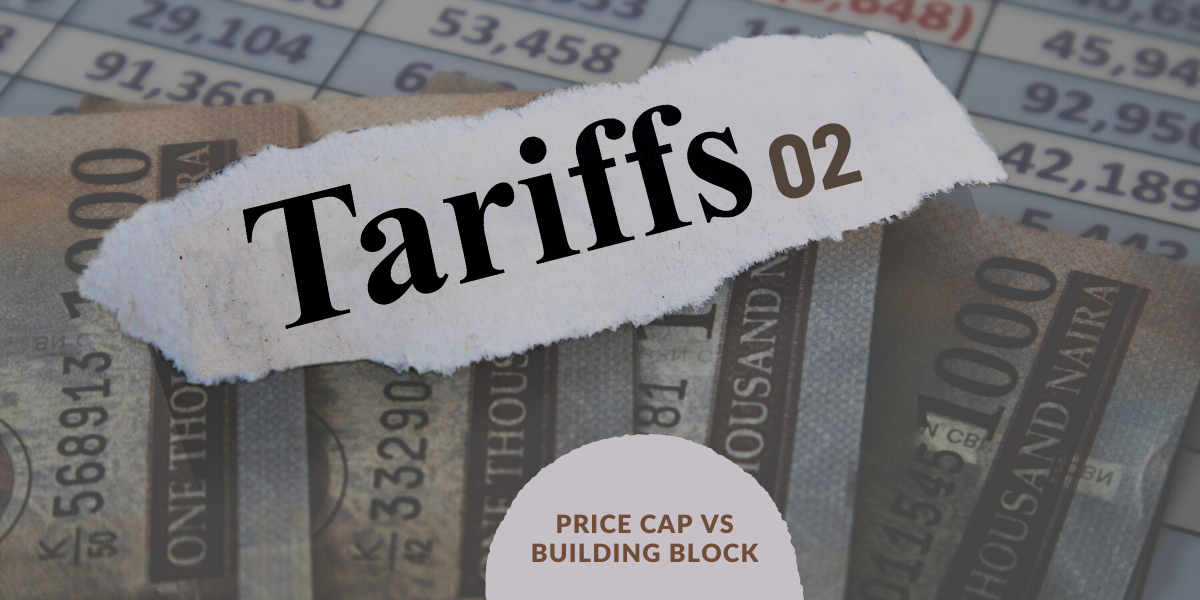
1. INTRODUCTION
In our last article (Part 1 of the tariff series “Understanding Electricity Tariffs”), we discussed the regulation of electric utilities. It was established that the regulation of utilities is challenging because of the regulator’s requirement/need to strike a balance between investor and consumer interests. Across the world, Regulators have used diverse strategies to achieve this balance. This article will focus on the Incentive-based methodology of determining tariffs and discuss two key tariff methodologies under it. These tariff methodologies are called:
- Price-Cap regulation
- Building blocks approach
The price-cap regulation tariff methodology is used in over 15 countries including the United Kingdom which will be the case study for this article while the building blocks approach is a tariff methodology that is typically used in countries such as Ireland and Australia. It is also the tariff methodology employed in the Nigerian Electricity Supply Industry (NESI).
2. REGULATION OF ELECTRICITY UTILITIES
According to the International Financial Reporting Standards (IFRS)1, there are two main categories of regulatory schemes for electricity utilities:
- Cost-Based Regulatory Scheme
- Incentive Based Regulatory
Schemes Cost-based regulatory schemes seek to reimburse utilities for all production-related expenses. An example of this regulatory scheme is “The Rate of Return or Cost of Service regulation”, this regulation compensates utilities for required expenses and enables them to earn a reasonable return. Conversely, the incentive-based regulatory scheme aims to incentivize utility investors to increase their efficiency under predetermined benchmarks. A good example of an incentive-based regulatory scheme is price cap regulation, which encourages utilities to reduce their costs and earn a return from the difference in the cost reduced
3. PRICE-CAP REGULATION
In the simplest form of the price cap regulation, the regulator sets a cap, or maximum price for the tariff utilities may charge customers. This cap could be a total cap on the tariff, a cap on profit, a cap on a specific cost in the tariff components or a cap on the difference between a supplier’s most expensive and most affordable tariffs. To illustrate, let us assume that a supplier’s most expensive and most affordable tariffs differ by 85%, and are set at N50/kWh and N20/kWh respectively. If the regulator orders that the allowed maximum difference between these costs should be set at 5%, the utility will be compelled to either raise its cheapest tariff or reduce its most expensive tariff to comply with the order. This 5% difference set by the regulator is called a relative price cap. Additionally, price caps may apply to a particular customer demographic.
In Nigeria for example, residential customers who use less than 50 kW/h of electricity per month enjoy a price cap of N4/kWh for each unit of electricity consumed, these customers are called “Lifeline Customers” and are subsidized by other tariff classes. While in the United Kingdom, the price cap is applied to each kWh of energy purchased by customers under a variable rate tariff.
In the UK electricity market, there are 2 main types of tariffs: the variable rate tariff and the fixed tariff. The main difference between these two tariff types is that under the variable tariff, the utility can increase or decrease prices as it sees fit or whenever the price cap is changed by the regulator, while customers under a fixed tariff pay a contractual standing rate negotiated with the utility which expires on a specific date. The goal of the price cap is to protect customers under a variable rate tariff who have not negotiated a fixed rate with the utility.
In the UK, the price cap applied per kWh of electricity consumed is applied on the following:
1. The wholesale cost of electricity – This is the cost of electricity procured from generation companies.
2. Network costs – This comprises the cost of building and maintaining transmission and distribution infrastructure.
3. Supplier’s operating costs – This consists of metering, billing, industry charges, sales, marketing, central overheads, customer relations and office costs.
4. Cost of government policy – Larger suppliers are mandated to support national energy policies.
5. Profit – Here, the profit that may be earned by the utility is capped at 1.9% of the company’s revenue after the cost of goods and operating expenses have been deducted.
6. Value-Added Tax3 (VAT) – This is capped at a reduced rate of 5%. The standard VAT rate in the UK is 20%.
Price Cap regulation is commonly used to encourage utilities to reduce their operating costs. Service providers who are subject to this form of regulation are often required to adopt innovative cost-cutting methods to break even. Ideally, they should be able to increase their revenue while maintaining the same quality of customer service. However, studies have shown that in some instances, service providers have reduced the quality of their services and sometimes even withheld services to low-income households to achieve cost reductions for their businesses.
Nevertheless, price caps have been applied successfully to protect the interests of customers in countries like the United Kingdom, the United States, Portugal, Spain, and other European Union member states. Typically, a price cap limits the operating expenses of service providers to a certain amount, and utilities who take efficient operating steps to keep their costs below capped level are allowed to retain the difference. However, these caps do not last forever, they are reviewed periodically and during each review, some of that profit from efficient operations is passed on to the customer. To illustrate, in Italy the operating costs of distributors in the power sector are capped at the beginning of each regulatory period of four years, and under the new price cap, distributors are only allowed to keep 50% of the costs saved because of their efficiency during the previous regulatory period.
4. BUILDING BLOCKS APPROACH
The “building blocks” strategy used in Nigeria is a hybrid regulatory framework. It permits utilities to recover production costs and investment returns, while also incentivizing them to increase efficiency and lower costs by setting reasonable and efficient tariffs for the sector. The goal of this regulatory strategy which is used to regulate the electricity value chain is to set the allowed revenue and prices for utilities based on projections of effective costs. The goals of the regulator under this scheme are:
- Set an allowed revenue threshold for utilities.
- Determine the price of the customer tariffs to ensure recovery of the allowed revenue.
The projected values of a distinct set of building blocks are used to set the allowed revenue and tariffs. There are 3 standard building blocks as follows:
1. Allowed Return on Capital – This is the interest recovered on the capital investment made by an investor.
2. Allowed Return of Capital – This is the recovery of the capital invested in buying infrastructure or building/developing the infrastructure.
3. Efficient Operating Costs and Overheads – This is the actual cost the business incurred in providing services to customers. For example, the staff and maintenance costs.
Using these building blocks, the regulator determines an allowed revenue for the utility and uses that amount to set the customer tariff. In Nigeria, the regulator sets a specific tariff for customer class and the utilities have no control over the rates they charge. However, regulators who adopt the building blocks approach may also adopt the price cap regulation by setting a price ceiling for the tariffs as seen in Australia.
A key advantage of the “building blocks” tariff methodology is that it seeks to guarantee that utilities recover their costs, and receive fair compensation for services and returns on investments made.
A detailed explanation of the building block approach in Nigeria can be found in our last article.
5. BUILDING BLOCKS VS PRICE CAP REGULATION
In this section, we look at the factors that cut across both regulations
6. CONCLUSION
It is evident from the preceding that the building block approach and the price cap regulation are very similar. Both methods call for regulators to set tariffs that safeguard market and customer interests and motivate service providers to operate effectively. The building block strategy, however, specifically provides for a return on investment. Thereby guaranteeing that service providers are compensated for their efforts and encouraged to make investments that improve service delivery.
Evidence from countries such as the United Kingdom, Italy, Australia, and Nigeria shows that regulators can combine and adapt different methodologies to suit their objectives, and often do. Nigeria’s current tariff regime borrows some components from the price cap regulation by setting a lifeline tariff and a limit on annual operational and capital expenditure, but it also allows a rate of return on investments. Italy adopted a price cap regulation but caps only the Operating Expenditure (OPEX). In the UK, where price cap regulation is also practised, the tariff is capped for some customers by placing a ceiling on its cost components. Thus, regulators have the discretion to adopt and apply these regulations in dynamic ways.
However, this results in some confusion in the literature on the subject as some authors view the cost of service/rate of return regulation as an incentive-based methodology and others do not. Furthermore, comparing the different approaches is made difficult by the fact that while countries may state that they have adopted a particular methodology, there may be elements of seemingly opposing methodologies in their tariff regime as seen in Nigeria where elements of the rate of return and price cap methodologies have been applied concurrently in the building blocks approach practised.
Nevertheless, hybrid schemes give regulators a better chance of setting tariffs that may suit their objectives. For example, before the current tariff methodology was adopted, the NESI was plagued with many issues such as a lack of investment, poor infrastructure, and poor supply. Thus, the regulator needed to adopt a regime that would stimulate investment, improve service delivery, and offer customers access to electricity at a fair price.
To that end, the regulator adopted the building blocks approach which combines rate of return and price cap regulation to meet these objectives by ensuring investors make a return on their investment and thereby encouraged to make more investments that improve efficiency service delivery in the sector.
For a long time in Nigeria, even while the building blocks methodology was being applied, tariffs did not accurately reflect all costs as the methodology required and this hindered investment and growth in the electricity sector. Currently, tariffs in the NESI are cost-reflective, and we hope that this will lead to the required growth and improvement, thereby allowing investors and customers to benefit from the building block tariff methodology.












